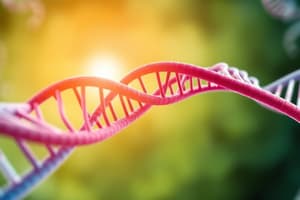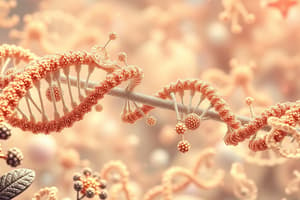Podcast
Questions and Answers
Which type of cell has 3 RNA polymerases?
Which type of cell has 3 RNA polymerases?
- Prokaryotic cells
- Eukaryotic cells (correct)
- Both prokaryotic and eukaryotic cells
- None of the above
What group of proteins in eukaryotes recognize promoter elements and load RNA polymerase at the start site?
What group of proteins in eukaryotes recognize promoter elements and load RNA polymerase at the start site?
- Repressor proteins
- Transcription activators
- σ-factors (correct)
- General transcription factors
Which group of factors in eukaryotes are involved in recognizing promoter elements and assembling pre-initiation complex?
Which group of factors in eukaryotes are involved in recognizing promoter elements and assembling pre-initiation complex?
- RNA polymerase
- General transcription factors (correct)
- σ-factors
- Transcription activators
In bacteria, the lac operon is regulated by an activator protein called CAP, which stands for:
In bacteria, the lac operon is regulated by an activator protein called CAP, which stands for:
Which type of cells regulate gene expression by adjusting enzymatic machinery and structural components to changes in nutritional and physical environment?
Which type of cells regulate gene expression by adjusting enzymatic machinery and structural components to changes in nutritional and physical environment?
Which type of cells normally synthesize only proteins required for survival under current conditions?
Which type of cells normally synthesize only proteins required for survival under current conditions?
How does the structure of Eukaryotic RNA polymerases compare to E.coli RNA polymerase?
How does the structure of Eukaryotic RNA polymerases compare to E.coli RNA polymerase?
In eukaryotic RNA polymerases, how many large subunits are typically present?
In eukaryotic RNA polymerases, how many large subunits are typically present?
What happens to the clamp domain of RNA polymerase II when downstream DNA is inserted?
What happens to the clamp domain of RNA polymerase II when downstream DNA is inserted?
Which type of RNA polymerase has a unique carboxy-terminal domain?
Which type of RNA polymerase has a unique carboxy-terminal domain?
How does the complexity of eukaryotic RNA polymerases compare to bacterial RNA polymerase?
How does the complexity of eukaryotic RNA polymerases compare to bacterial RNA polymerase?
How many smaller subunits are common across two or all three eukaryotic RNA polymerases?
How many smaller subunits are common across two or all three eukaryotic RNA polymerases?
Which RNA polymerase synthesizes tRNAs and 5S rRNA?
Which RNA polymerase synthesizes tRNAs and 5S rRNA?
What is the structure of eukaryotic RNA polymerases compared to prokaryotic RNA polymerases?
What is the structure of eukaryotic RNA polymerases compared to prokaryotic RNA polymerases?
What is the unique feature of carboxy-terminal domain (CTD) of eukaryotic RNA polymerase II?
What is the unique feature of carboxy-terminal domain (CTD) of eukaryotic RNA polymerase II?
How is the synthesized RNA released in eukaryotic RNA polymerase II?
How is the synthesized RNA released in eukaryotic RNA polymerase II?
What is the role of activator proteins in transcriptional activation?
What is the role of activator proteins in transcriptional activation?
What does the crystal structure resolution of yeast RNA pol II reveal?
What does the crystal structure resolution of yeast RNA pol II reveal?
Flashcards are hidden until you start studying
Study Notes
RNA Polymerases
- Four multisubunit RNA polymerases have a similar overall design
- Eukaryotic RNA polymerases are more complex than E. coli RNA polymerase
- Eukaryotic RNA polymerases contain two large subunits and 10–14 smaller subunits
- Some subunits are common between the three eukaryotic RNA polymerases, while others are specific
Structure of RNA Polymerase II
- The clamp domain of RNA Polymerase II (RPB1) opens when downstream DNA is inserted and swings shut during elongation mode
- The shut position anchors the polymerase onto the downstream double-stranded DNA, making it very processive
Transcriptional Activation
- Activator proteins bind to specific transcription-control elements in promoter-proximal sites and distant enhancers
- Activator proteins interact with the multisubunit Mediator complex to assemble general transcription factors and RNA polymerase II (Pol II)
- Pol II initiates transcription, but pauses after transcribing fewer than 100 nucleotides due to the action of NELF (negative elongation factor)
- Activators promote association of the Pol II-NELF-DSIF complex with elongation factor P-TEFb, which releases NELF, allowing resumption of RNA transcription
Eukaryotic RNA Polymerases
- RNA polymerase I synthesizes pre-rRNA
- RNA polymerase II synthesizes mRNAs, small nuclear RNAs, and micro and small interfering RNAs (miRNAs and siRNAs)
- RNA polymerase III synthesizes tRNAs, 5S rRNA, and other small stable RNAs
Unique Features of Eukaryotic RNA Polymerase II
- Eukaryotic RNA polymerase II has a unique carboxy-terminal domain (CTD) on its RPB1 subunit
- The CTD is involved in multiple regulatory interactions, playing a key role in initiation, release, elongation, and processing of synthesized mRNAs
- The CTD contains 26 repeats of Tyr-Ser-Pro-Thr-Ser-Pro-Ser in yeast and 52 repeats in mammals
- Ser residues in the CTD are phosphorylated upon transition from initiation to elongation
Studying That Suits You
Use AI to generate personalized quizzes and flashcards to suit your learning preferences.




